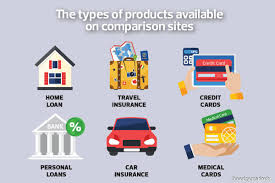
Financial Product Comparisons: Choose the Right Option for Your Wallet
When it comes to managing your money, choosing the right financial products is just as important as budgeting or saving. But with so many options—credit cards, bank accounts, personal loans, and more—it’s easy to feel overwhelmed.
That’s where product comparison tools and guides can help. By evaluating the features, fees, and benefits side by side, you can make smarter decisions that align with your financial goals.
In this guide, we break down the key products most people use, what to look for, and how to compare them effectively.
Why Compare Financial Products?
Not all financial products are created equal. The “best” option isn’t necessarily the one with the lowest rate or the flashiest promotion—it’s the one that suits your personal financial situation.
Here’s why comparing is essential:
- You can avoid hidden fees and high interest rates
- You’ll find products that match your goals (e.g., cashback, travel rewards, savings growth)
- You’ll improve your credit health and financial flexibility
- You might save hundreds—or even thousands—over time
1. Credit Cards
Whether you’re looking to build credit, earn rewards, or finance a purchase, choosing the right credit card can make a big difference.
What to Compare:
- Interest Rate (APR): Lower is better if you tend to carry a balance
- Annual Fee: Some cards charge $0, while others may cost over $100/year
- Rewards: Cashback, travel miles, points—choose what fits your lifestyle
- Intro Offers: Look for 0% APR promos or welcome bonuses
- Foreign Transaction Fees: Important if you travel or shop internationally
- Credit Score Requirements: Some cards require good/excellent credit
Example:
| Feature | Card A | Card B |
|---|---|---|
| APR | 19.99% | 14.99% |
| Annual Fee | $0 | $95 |
| Rewards | 1.5% cashback | 3% on travel, 1% elsewhere |
| Intro Offer | None | $200 bonus after $1,000 spent |
2. Bank Accounts (Checking and Savings)
Your checking and savings accounts are the foundation of your finances—but they shouldn’t cost you money just to use them.
What to Compare:
- Monthly Fees: Aim for no monthly maintenance fees
- Minimum Balance Requirements: Some banks waive fees if you maintain a balance
- ATM Access: Nationwide ATM network or fee-free withdrawals
- Mobile App & Online Tools: User-friendly digital banking experience
- Interest Rate (for savings): Compare APY (Annual Percentage Yield)
- Overdraft Policies: Know what happens if you go below zero
Example:
| Feature | Bank A | Bank B |
|---|---|---|
| Checking Fee | $0 | $12/month (waived with $1,500 balance) |
| ATM Network | 60,000+ | 20,000 |
| Savings APY | 0.01% | 3.50% |
| Mobile App | Basic | Advanced with budgeting tools |
Tip: Online banks often offer higher savings rates and fewer fees than traditional banks.
3. Personal Loans
If you need to consolidate debt, fund a large purchase, or cover unexpected expenses, personal loans can offer quick access to cash—with fixed repayment terms.
What to Compare:
- Interest Rate (APR): Based on your credit score—lower is better
- Loan Amount: Minimum and maximum you can borrow
- Repayment Term: Typically 2–7 years
- Fees: Origination, late payment, or early payoff penalties
- Funding Time: Some lenders deposit funds as soon as the next day
- Credit Requirements: Some lenders cater to fair/poor credit borrowers
Example:
| Feature | Lender A | Lender B |
|---|---|---|
| APR | 8.99% – 19.99% | 6.50% – 24.00% |
| Loan Amount | $1,000–$50,000 | $5,000–$35,000 |
| Term | 2–5 years | 3–7 years |
| Origination Fee | 1% – 6% | None |
| Funding Time | 1–2 business days | Same-day possible |
4. Other Products Worth Comparing
- Auto Loans: Shop around for interest rates before going to the dealership
- Student Loans: Compare federal vs. private options based on interest and flexibility
- Mortgage Rates: A small difference in rates can mean thousands over 30 years
- Insurance: From renters to life insurance—coverage, premiums, and deductibles matter
Where to Compare Financial Products
There are many trusted websites and apps that allow you to compare financial products side by side. A few popular options include:
- NerdWallet
- Bankrate
- Credit Karma
- LendingTree
- The Points Guy (for travel rewards and credit cards)
These platforms often offer tools that let you filter by credit score, goals, or monthly budget.
Final Tips for Making the Best Choice
- Know Your Credit Score: It affects your eligibility and rates
- Read the Fine Print: Look beyond the flashy features—check for hidden fees
- Align with Your Goals: Pick products that support your lifestyle and needs
- Compare at Least 3 Options: Don’t go with the first offer
- Review Regularly: Financial needs change—your products should evolve too
Final Thoughts
Making smart financial choices starts with knowledge. By comparing products side by side, you gain control over your money and avoid costly mistakes. Whether you’re picking your first credit card or switching banks for better savings, a little research goes a long way.
So before you sign up, swipe, or borrow—compare first, and save smarter.